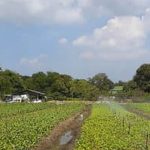The Central Valley of California is not only known for its rich agricultural history, but also for its perfect climate and soil for growing a wide variety of vegetables. Whether you are a seasoned gardener or a beginner, Central Valley vegetable gardening offers an abundance of options to explore and enjoy. From preparing the soil to managing pests and diseases, this article will guide you through the best practices for successful vegetable gardening in the Central Valley.
With its fertile land and diverse climate, the Central Valley has been a hub for agricultural production for generations. In this section, we will delve into the unique characteristics that make the Central Valley an ideal location for growing vegetables. We will also explore how the region’s agricultural history has shaped the practices and traditions of vegetable gardening in this area.
From selecting the best vegetable varieties to navigating planting schedules and irrigation techniques, there are many factors to consider when embarking on a successful vegetable garden in the Central Valley. This article will provide valuable insights into these considerations, as well as tips for pest and disease management specific to the region. Additionally, we will discuss resources and events available to community members interested in taking their love of gardening to new heights in the Central Valley.
Best Vegetable Varieties for Central Valley Climate and Soil
When it comes to central valley vegetable gardening, it’s important to select the right varieties that are well-suited for the unique climate and soil of this region. The Central Valley experiences hot, dry summers and mild winters, making it ideal for growing a wide variety of vegetables. Here are some of the best vegetable varieties to consider for your Central Valley garden:
- Tomatoes: Varieties such as Early Girl, Roma, and Celebrity perform well in the Central Valley’s warm climate.
- Zucchini: This fast-growing summer squash thrives in the hot weather of the Central Valley. Varieties like Black Beauty and Golden Harvest are popular choices.
- Peppers: Both sweet and hot pepper varieties, including Bell peppers, Jalapenos, and Anaheims, do well in the warm climate of the Central Valley.
- Green Beans: Bush and pole bean varieties such as Blue Lake and Kentucky Wonder are well-adapted to the Central Valley’s soil and temperature conditions.
In addition to these vegetable varieties, other suitable options for your central valley vegetable garden include cucumbers, eggplants, melons, and squash. It’s important to choose heat-tolerant and disease-resistant varieties that can withstand the conditions specific to the Central Valley.
It’s also worth considering heirloom varieties that have been passed down through generations and are well-adapted to local growing conditions. These heirloom vegetables often have unique flavors and characteristics that make them a delightful addition to any Central Valley vegetable garden. By selecting the best vegetable varieties for your central valley garden, you can set yourself up for a successful growing season with bountiful harvests of fresh produce.
Preparing the Soil for Successful Vegetable Gardening
When it comes to successful Central Valley vegetable gardening, preparing the soil is crucial for healthy and bountiful crops. The region’s soil is known for its fertility, but it still requires proper care and preparation to ensure optimal growing conditions for vegetables.
One of the first steps in preparing the soil is to test its pH level and nutrient content. Most vegetables thrive in slightly acidic soil with a pH level between 6.0 and 7.0, so adjusting the pH if necessary will significantly benefit the growth of your crops.
In addition to testing and adjusting the pH level, it’s essential to enrich the soil with organic matter such as compost, aged manure, or cover crops. These organic materials improve soil structure, provide essential nutrients, and promote beneficial microbial activity. Working organic matter into the soil also helps with moisture retention and drainage, which are both important factors in Central Valley vegetable gardening due to its hot and dry climate.
Furthermore, consider using raised beds for your vegetable garden in the Central Valley. Raised beds offer better drainage and aeration compared to traditional garden plots while also allowing for better control over soil amendments and fertilization. By taking these preparatory steps to care for your soil, you can set a strong foundation for a thriving vegetable garden in the fertile grounds of the Central Valley.
| Aspect | Information |
|---|---|
| pH Level | 0-7.0 is ideal for most vegetables |
| Organic Matter | Add compost, aged manure or cover crops to enrich the soil |
| Raised Beds | Better drainage and aeration compared to traditional garden plots |
Planting Schedule and Best Practices for Central Valley Vegetable Gardening
Understanding the Central Valley Climate
The Central Valley of California experiences a Mediterranean climate, characterized by hot, dry summers and mild, wet winters. This climate is ideal for growing a wide variety of vegetables, making it important to understand the planting schedule and best practices to maximize yields. With the region’s long growing season, vegetable gardeners in the Central Valley have the opportunity to plant multiple crops throughout the year.
Year-Round Planting Guide
In the Central Valley, vegetable gardeners can take advantage of year-round planting opportunities due to the mild winter temperatures. Cool-season crops such as lettuce, spinach, and peas thrive in the winter months, while warm-season crops like tomatoes, peppers, and squash are best planted in the spring after any chance of frost has passed. It’s important to plan ahead and stagger plantings to ensure a continuous harvest throughout the seasons.
Soil Preparation and Fertilization
Before planting vegetables in the Central Valley, it is crucial to prepare the soil properly. The region’s soil may require amendments such as compost or organic matter to improve its structure and fertility. Conducting a soil test can provide valuable information on nutrient levels and pH balance, allowing gardeners to make informed decisions about fertilization. Additionally, implementing crop rotation practices can help maintain soil health and reduce the risk of disease buildup.
By following these planting schedule and best practices for central valley vegetable gardening, gardeners can enjoy bountiful harvests year-round while maximizing their use of this fertile region’s resources. With proper planning and care, vegetable gardens in the Central Valley can thrive and provide an abundance of fresh produce for families to enjoy.
Watering and Irrigation Tips for Vegetable Gardens in the Central Valley
When it comes to vegetable gardening in the Central Valley, one of the most crucial aspects to consider is proper watering and irrigation. The region’s hot summers and sometimes limited water supply can pose challenges for gardeners, but with the right techniques, you can successfully grow a thriving vegetable garden.
Understanding Central Valley Climate and Water Needs
The Central Valley is known for its Mediterranean climate, characterized by hot, dry summers and mild, wet winters. This means that during the peak growing season, vegetable plants will require consistent and adequate watering to thrive. Understanding the specific water needs of different vegetables and adapting your irrigation practices accordingly will be essential for a successful harvest.
Choosing the Right Irrigation System
Given the climate of the Central Valley, drip irrigation systems are often recommended for vegetable gardens. These systems deliver water directly to the base of plants, minimizing waste through evaporation and runoff. Additionally, using mulch around your vegetable plants can help retain soil moisture and reduce water usage.
Watering Best Practices
In order to conserve water while still meeting the needs of your vegetable garden, it’s important to establish a regular watering schedule. Early morning or late afternoon are generally the best times to water your garden, as these times minimize water loss due to evaporation. Monitoring soil moisture levels and adjusting your watering frequency based on weather conditions will also be crucial for maintaining a healthy garden while conserving water resources in the Central Valley.
Pest and Disease Management Specific to Central Valley Vegetable Gardens
The central valley of California is known for its rich agricultural history and fertile soil, making it an ideal location for vegetable gardening. However, with the benefits of this prime location come certain challenges when it comes to pest and disease management. Due to the warm climate and abundance of crops, Central Valley vegetable gardens are often susceptible to a variety of pests and diseases that can hinder successful gardening.
One common pest that gardeners in the Central Valley may encounter is the tomato hornworm. These large green caterpillars can quickly defoliate tomato plants if not properly managed. Additionally, aphids are another common issue in this region due to the warm weather, which provides optimal conditions for their reproduction. It is important for gardeners in the Central Valley to be vigilant in monitoring their plants for signs of these pests and to take proactive measures to control their populations.
In terms of diseases, fungal infections can pose a significant threat to vegetable gardens in the Central Valley due to the frequent presence of moisture from irrigation and high temperatures. Common fungal diseases include powdery mildew and various types of blight. Gardeners must implement proper watering techniques, such as avoiding overhead watering, and maintaining good air circulation around plants to mitigate the risk of fungal diseases.
Overall, while pest and disease management may present challenges for Central Valley vegetable gardeners, with proper knowledge and proactive measures, it is certainly possible to maintain a thriving garden in this bountiful region.
| Pests | Diseases |
|---|---|
| Tomato hornworm | Powdery mildew |
| Aphids | Blight |
Harvesting and Preserving Your Central Valley Vegetable Garden’s Bounty
Once you have put in the hard work of planting and nurturing your vegetable garden in the Central Valley, it’s time to reap the rewards of your efforts. Here are some tips for harvesting and preserving your Central Valley vegetable garden’s bounty:
- Harvesting: When it comes to harvesting vegetables in the Central Valley, timing is key. Make sure to pick your produce at the peak of ripeness for the best flavor and nutritional value. Use a sharp pair of gardening shears or a knife to gently harvest your vegetables to avoid damaging the plants. Some popular vegetables that thrive in the Central Valley climate and are ready for harvesting include tomatoes, peppers, squash, cucumbers, and green beans.
- Preserving: Once you have harvested your bountiful yield, you may find yourself with more vegetables than you can consume fresh. This is where preservation methods come into play. Canning, pickling, freezing, and dehydrating are all effective ways to preserve your harvest for future use. For example, tomatoes can be canned into sauces or salsa, peppers can be pickled for a tangy addition to meals, and excess herbs can be dried for later use.
- Sharing with Others: Another way to enjoy the fruits of your labor is by sharing them with friends and neighbors. Consider organizing a food swap or donating excess produce to local food banks or community organizations.
By carefully harvesting and preserving your Central Valley vegetable garden’s bounty, you can enjoy homegrown produce throughout the year while reducing food waste at the same time.
Community Resources and Events for Central Valley Vegetable Gardeners
The Central Valley in California has a rich agricultural history, and vegetable gardening is a popular activity for many residents. One of the keys to successful central valley vegetable gardening is taking advantage of the wealth of community resources and events available to gardeners in the area.
One valuable resource for central valley vegetable gardeners is the local Cooperative Extension office. They provide research-based information on topics such as soil health, irrigation management, pest control, and much more. The Master Gardener program, offered through the Cooperative Extension, also provides educational workshops and community outreach to support vegetable gardeners in the Central Valley.
In addition to resources provided by the Cooperative Extension, there are also numerous events geared towards vegetable gardening enthusiasts in the Central Valley. These can include plant sales, seed exchanges, workshops on topics such as organic gardening or composting, and tours of local gardens or farms.
Attending these events can not only provide valuable information and tips for successful vegetable gardening but also connect you with other like-minded individuals in your community who share your passion for growing fresh, healthy produce in the Central Valley. By taking advantage of these community resources and events, you can enhance your central valley vegetable gardening experience and connect with others who share your love for growing food.
Conclusion
In conclusion, vegetable gardening in the Central Valley offers a unique and rewarding experience for both seasoned gardeners and beginners alike. The region’s rich agricultural history sets the stage for a thriving gardening community, with a wealth of resources and events to support and inspire gardeners.
By selecting the best vegetable varieties suited to the Central Valley’s climate and soil, preparing the soil properly, following a planting schedule, implementing efficient watering and irrigation practices, managing pests and diseases, and harvesting the garden’s bounty, Central Valley gardeners can enjoy a successful and fruitful growing season.
One of the most important aspects of central valley vegetable gardening is understanding the specific needs of this region’s climate and soil. By choosing varieties that thrive in the area’s conditions and taking steps to prepare the soil accordingly, gardeners can set themselves up for success. Proper watering techniques are also essential to ensure healthy plant growth in this arid region.
Additionally, dealing with pests and diseases requires vigilance and knowledge about managing these challenges specifically within a Central Valley context. With dedication and care, Central Valley gardeners can enjoy an abundant harvest from their vegetable gardens.
For those interested in delving deeper into central valley vegetable gardening or connecting with others who share their passion for growing their own food, there are numerous community resources and events available throughout the Central Valley. These opportunities provide valuable information, support networks, and inspiration for gardeners looking to further develop their skills and knowledge.
Embracing the joy of vegetable gardening in the Central Valley means participating in this vibrant community while enjoying all that nature has to offer in this fertile region.
Frequently Asked Questions
What Grows Well in Central Valley California?
Central Valley California has a Mediterranean climate, making it suitable for growing a variety of crops such as almonds, tomatoes, grapes, and citrus fruits. The region’s fertile soil and long growing season make it ideal for agriculture.
When Should I Plant My Garden in Central California?
In Central California, the best time to plant your garden is typically in the early spring after the last frost. This allows enough time for your crops to grow before the intense summer heat arrives. Planning your garden around the region’s climate and growing season is essential for a successful harvest.
Can You Grow Vegetables All Year Round in California?
Yes, you can grow vegetables all year round in California due to its diverse microclimates. While some areas may experience colder winter temperatures, other regions have milder winters that allow for continuous vegetable cultivation. With proper planning and selection of cold-hardy crops, it is possible to have a year-round vegetable garden in California.

If you’re looking to get into vegetable gardening, or are just looking for some tips on how to make your current garden better, then you’ve come to the right place! My name is Ethel and I have been gardening for years. In this blog, I’m going to share with you some of my best tips on how to create a successful vegetable garden.





